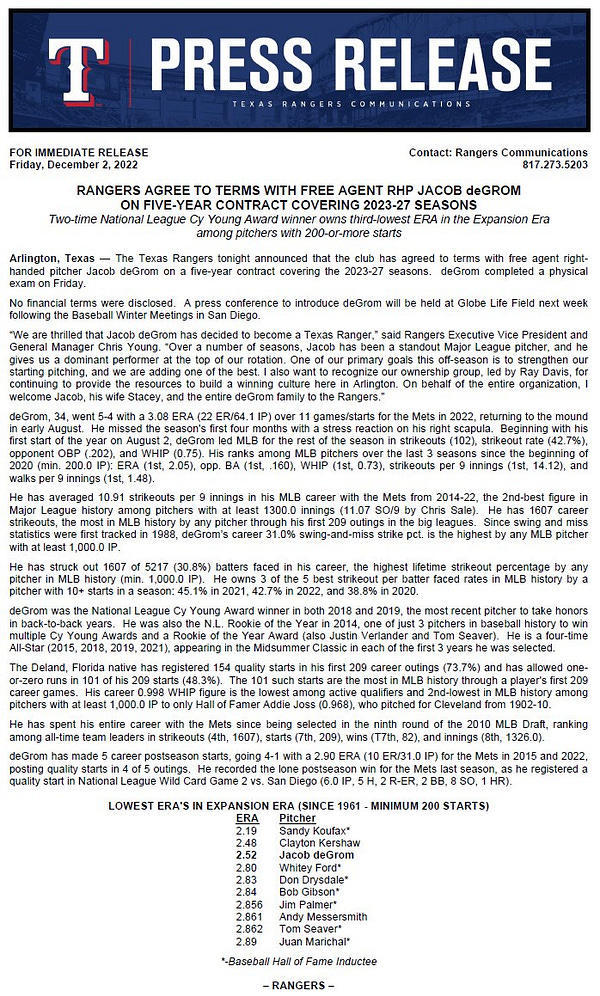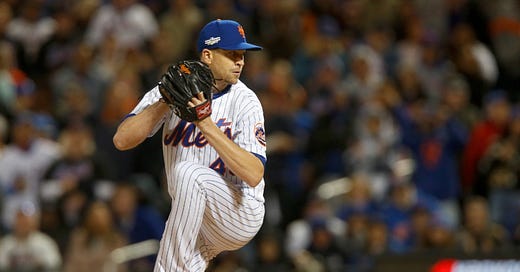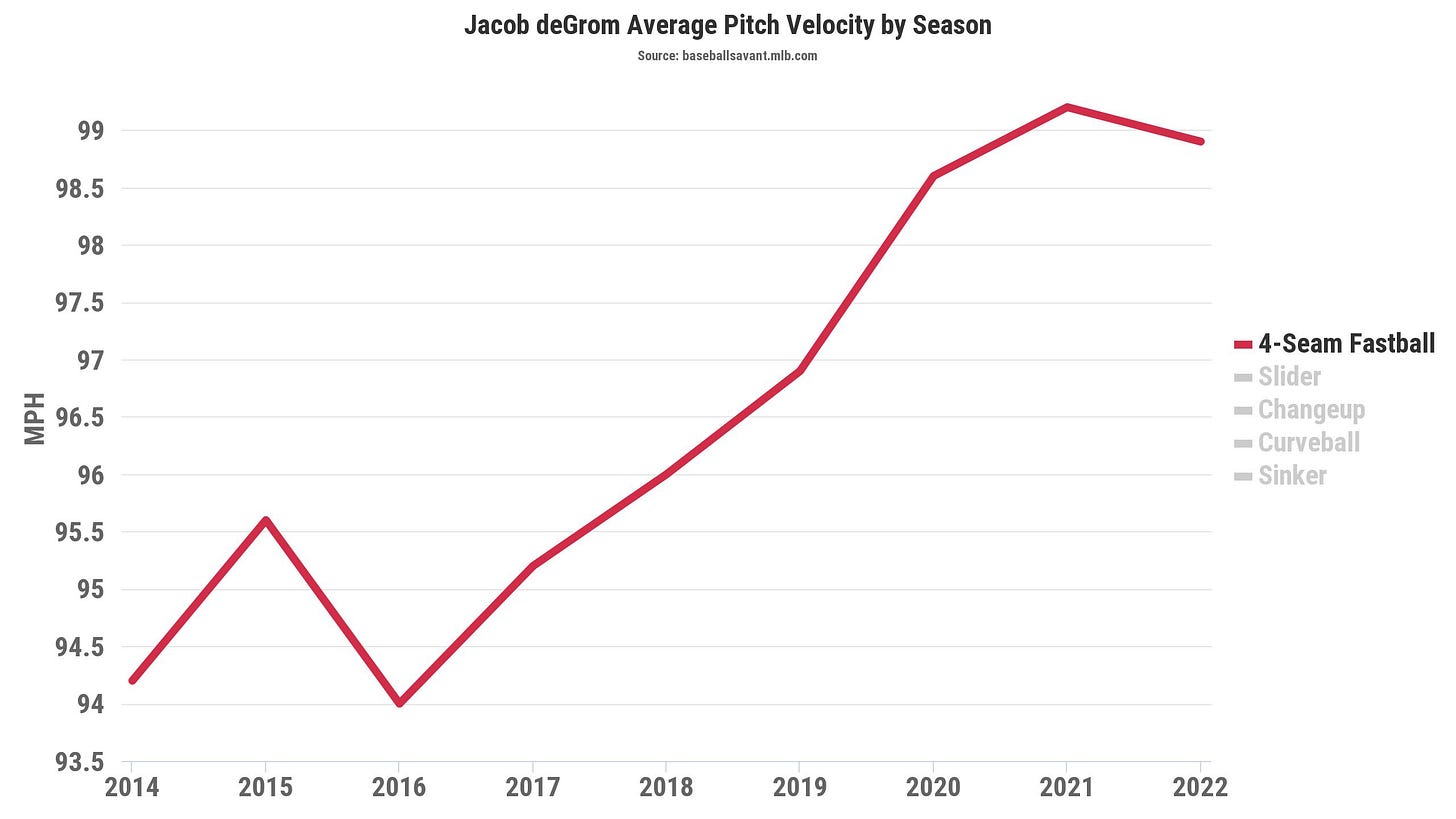The Jacob deGrom Contract Has Upside Too
Yes it's risky, but that doesn't mean it's all downside
A breakdown:
156 1/3 - The number of regular season innings deGrom pitched in 2021-22.
$185 million - The guaranteed dollars he signed for entering his age-35 season.
2.05 - deGrom’s ERA from 2018-22.
30.3% - His K-BB% rate during the same timeframe.
These are the numbers needed to paint the picture of what exactly transpired on Friday night when the Texas Rangers’ PR account shockingly and out of nowhere announced the deGrom signing:


Up until this point in the offseason the belief was that deGrom would sign for a near-record AAV (he wound up with $37 million per year, the 2nd highest on record for a starting pitcher), but that it would be on a short-term deal.
The Mets were reportedly discussing a 3-year, $120 million contract with their longtime ace. A deal like the Mets’, while not without risk, certainly decreases the likelihood of the contract ending in disaster. Should deGrom continue to seriously struggle with even getting on the mound, this move could cripple Texas’ franchise for quite a while.
I’ll get to the Rangers’ team-level side of this in a minute. The Mets’, too. But let’s stay on deGrom for a second, because the obvious first reaction to this move is “too many years” and that Texas made a gigantic mistake.
Nobody is going to deny deGrom’s recent health troubles, but I do feel they’ve begun to fully overshadow just how dominant he has been since 2018.
Despite the missed time in recent years deGrom still has the most fWAR since 2018. He ranks first in the majors in ERA, FIP, xFIP, and K-BB%. He’s second in WHIP.
He’s had two injury-marred seasons and is getting up there in age, but one of the biggest reasons the Mets wanted to extend him in recent years was that his time spent coming up as a shortstop reduced the wear and tear on his arm. Should just ignore that now?
While most pitchers around his age begin to decline, deGrom has already proven to be an outlier. A freak, if you will.
That’s because one of the reasons pitchers decline as they get older is due to diminishing velocities, which hasn’t been a problem for the newest Ranger:
This isn’t supposed to happen. Perhaps throwing so hard for so long is what led to his body breaking down these past two years. But we also need to note that other HOF-caliber arms such as Justin Verlander and Max Scherzer have recently defied modern aging curves.
deGrom has been very open about his desire to remain effective, and dominant, into his 40s. The contract is extremely high-risk, yes, but it comes with monstrous upside as well.
Since the Rangers are coming off a 68-win campaign and deGrom has only pitched partial season in back-to-back years, most of the discourse is focusing on the downside. There are outcomes where this works out well for Texas, though. One of the best starting pitchers of the millennium was on the open market, and they got him.
The deGrom deal follows last winter’s mega spending spree by the Rangers - the one where they paid Corey Seager $325 million, Marcus Semien $175 million, and Jon Gray $56 million. This offseason, they already gave Martin Perez the 1-year, $19.65 million qualifying offer. Add it all up and it comes out to roughly $760 million in commitments.
GM Chris Young is essentially trying to buy his way into contention. All of these deals are likely overpays, but what else was Texas supposed to do? Players of this stature aren’t lining up to join a 68-win team in the same division as the Astros, Mariners, Mike Trout, and Shohei Ohtani. The franchise hasn’t had a winning season since 2016. At least they’re trying to improve.
For it to work out for the Rangers they’ll need to supplement their pricey stars with cheap, homegrown talent. The good news is their farm isn’t barren. Josh Jung debuted in September. Outfielders Dustin Harris and Evan Carter could are on their way. Pitchers Jack Leiter, Kumar Rocker, Owen White, Brock Porter, and Cole Winn are all interesting.
Outside of the big stars, they really aren’t paying anyone much of anything as early as 2024 even. They now have a couple seasons to see which youngsters are worth further investing in.
I’m more bullish on this contract working out deGrom-wise than I am Rangers-wise, but the long-term finances aren’t as messy as you might think. By 2026 they’re committed to just three players:
As for the Mets, this has to sting. Not only did deGrom leave, but he reportedly didn’t give New York a chance to make a final offer. I’m not a Mets fan and therefore won’t write from the perspective of one. deGrom’s place in Mets history is another conversation altogether, one that probably shouldn’t be addressed emotionally by Mets fans until the dust has settled.
Baseball wise, and for 2023, they’ll be fine. I’d put the odds of the team signing one of Justin Verlander or Carlos Rodon at 99%? They’ll likely get another arm and probably re-sign Brandon Nimmo, too. They won 101 games in 2022 despite getting just 11 starts from deGrom.
The last sector of this blockbuster I’ll address is fantasy, though there isn’t much actionable info here. A bet on deGrom in any form of fantasy baseball — redraft, dynasty, best ball — is a bet on health. Pitching in New York or Texas won’t change much. He never got much run support with the Mets, anyways, which mitigates risk if the Rangers don’t improve as much as they hope to.








